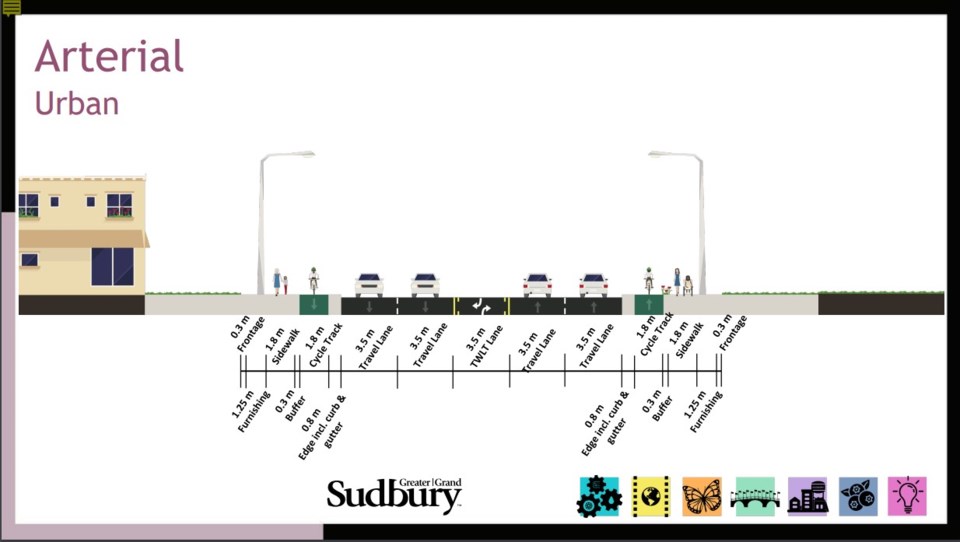Greater Sudbury streets are in for a long-term makeover, with the city poised to move forward with its Complete Streets Policy.
City council adopted the policy in 2018, which aims to encourage people to use active and public transportation to navigate city streets.
A significant component of this effort centres on how city roads are constructed, with a series of proposed street cross-sections presented to the city’s operations committee earlier this week.
The effort marks a “deliberate paradigm change in how public roads are being used,” city traffic and asset management supervisor Joe Rocca told the committee.
“We do anticipate that some of the proposed changes will not be well received, but we’re looking forward to having those conversations with the community and incorporating that feedback into the next draft of the typologies.”
The street cross-section mockups range depending on the type of street and location, but typically include bike lanes and sidewalks. Rural residential roads lack bike lanes, which drew the attention of Ward 12 Coun. Joscelyne Landry-Altmann, who argued there should be.
“Local roads, be it rural or urban roads, typically have lower speed and volumes, and based on that the recommended cycling type for that would be a shared street,” city active transportation co-ordinator LyAnne Chenier explained.
Many of the mockups also call for wider sidewalks, with 1.8 metres considered best practice and most city sidewalks currently measuring 1.5 metres wide. The city has also determined the ideal width for traffic lanes is 3.5 metres, though Ward 4 Coun. McCausland recommended even narrower streets to help slow down traffic and make conditions safer.
Rocca clarified they’re aiming for 3.3-metre-wide lanes downtown, and if they get much narrower than that, they might begin to cause issues during winter operations.
“It would require significant snow removal or a different mode of operations to keep that travel portion of the road open,” he explained.
“It is possible, you just need to use it in the right context and have some consideration for winter operations as well.”
These and various other considerations as it relates to what the ideal city street might look like in various areas of the city will form the basis for what the Complete Streets plan will look like, which Chenier said will inform existing policies, standards and guidelines.
The goal, she said, is to provide “a unified guidance on street planning and design to city staff, decision makers and external stakeholders.
“Complete Streets will improve the quality of life for Greater Sudbury residents and attractiveness for the community over the long term by providing a balanced and connected transportation system that enhances public health and safety, livability, quality, affordability and that supports increased economic activity and opportunity.”
Although the city hasn’t fully adopted their Complete Streets plan with approved street designs, they’ve already begun incorporating many of its elements into existing projects. The Bridge of Nations renovation city council approved last week, for example, will see the median removed and lanes narrowed to accommodate wider sidewalks and bicycle paths. This will co-ordinate it with the ongoing Paris/Notre Dame Bikeway project.
As for slowing traffic, the city is poised to begin dropping residential speed limits to 40 km/h in a pilot program. They are also set to begin installing traffic-calming bollards along 10 of the highest-ranked locations in the municipality this year.
Things have changed dramatically in the past few years, said Ward 9 Coun. Deb McIntosh, who also chairs the city’s operations committee.
“Back then they just fixed the road, they didn’t add to it,” she told Sudbury.com. “Now, I’m finding we don’t even have to say anything … you don’t have to fight for it, it’s happening.”
Adopting a range of approved street cross-sections, and incorporating them into various city planning documents, will help guarantee this forward momentum continues, she added.
“It’s a real evolution, and this is the next step in formalizing what these cross sections will look like.”
The city is planning on hosting virtual public consultations on June 27 and 29, with more information expected soon on the city’s website, which can be accessed by clicking here.
An Over to You page will also be created for people to weigh in on the process and learn more details about what is being proposed.
Tyler Clarke covers city hall and political affairs for Sudbury.com.
